🧱 Build your pages with blocks: no-code required!
Building beautiful pages is easy with Hugo Blox’s no-code block system.
No programming is required, just choose your blocks and arrange them how you like!
Loading pre-made layouts is a great way to kickstart your new homepage. Templates come with some popular blocks pre-configured for this purpose.
Content blocks empower you to fully customize your site. They display as sections on landing pages such as the homepage.
Multiple pre-designed blocks can be added, removed, and positioned as desired on your page. For example, you can use the Experience block both in an “Experience” section and in an “Education” section on your homepage.
Looking to build and publish a block that doesn’t exist yet? Create a new block - or just paste your shiny new HTML layout into the Markdown block together with your content.
The block system enables you to easily choose different blocks (designs) for the header (such as navigation bar), page sections, and the footer (such as copyright and links).

How do I use blocks?
Templates come with some popular content blocks pre-configured as homepage sections.
Start by opening your homepage at content/_index.md (or content/home/ for older sites) in the GitHub editor by going to this file in your GitHub repository and clicking the pencil icon to edit the file.
Delete any homepage sections that you don’t need and personalize the remaining section options. For example, you can set a custom color, image, or video based background for each section.
Remember to update your navigation menu in config/_default/menus.yaml if you need to add or remove links to your homepage sections after editing them. For example, if you change the id of the contact section from contact to contact-me, then you can update the /#contact link in menus.yaml to /#contact-me.
Create a section
To add a section to the homepage, create a new YAML item under sections in your content/_index.md.
Explore the Blocks page to find the content blocks that you wish to use in your site. Then copy and paste the block’s options into the YAML front matter of your Markdown page.
Remember to configure your sections within the page’s front matter, i.e. between a pair of triple dashes --- that represent YAML parameters.
The site Header and Footer blocks are special cases which can be customised within your config/_default/params.yaml.
For example, here are two text-based sections:
---# Page titletitle: My page# Page type - we want a landing page (such as a homepage)type: landing
# Your landing page sections - add as many different content blocks as you likesections: - block: markdown id: section-1 content: title: Section 1 subtitle: A subtitle text: Add any **markdown** formatted content here - text, images, videos, galleries - and even HTML code! - block: markdown id: section-2 content: title: Section 2 subtitle: A subtitle text: Add your Section 2 content here...---You can also add any common block options documented on this page, such as title, to the front matter.
You can link a homepage section from the site menu by editing config/_default/menus.yaml and adding the id of your section. For example, if your section has an id of section-1, reference it as "/#section-1" in the menu URL.
You can create as many content blocks as you wish, with each appearing in its own section.
Remove a section
If you do not require a particular section, you can simply delete any associated sections from the homepage at content/_index.md.
Taking the example above, we remove the second section, leaving us with only the first section:
---# Page titletitle: My page# Page type - we want a landing page (such as a homepage)type: landing
# Your landing page sections - add as many different content blocks as you likesections: - block: markdown id: section-1 content: title: Section 1 subtitle: A subtitle text: Add any **markdown** formatted content here - text, images, videos, galleries - and even HTML code!---After removing a section, you may wish to remove any links to it. To remove a navigation link from the top of the page, remove the associated main menu entry in config/_default/menus.yaml.
Position sections
Page sections appear in the order in which they are defined in your page front matter sections.
Simply cut and past the sections (starting with a YAML - block: ...) in the order that you require them.
To re-arrange homepage sections, edit the sections wihin the content/_index.md file.
Link to a section
You may wish to add a navigation link to the top of the page that points to a section. This can be achieved by adding something similar to the following lines to your config/_default/menus.yaml, where the URL will consist of the id of the section:
main: - name: Research url: /#research weight: 10Personalizing blocks
The parameters for each section consist of general options in addition to block-specific options.
Here we will discuss the common options that can be used in most content blocks. You can find the block-specific options on the Blocks documentation page.
We recommend using YAML formatted front matter (between a pair of ---). If your front matter is written in TOML syntax (between a pair of +++), you’ll need to convert it before using the YAML formatted snippets on this page.
Listing view
Several content blocks have a view option to let you choose how content is displayed.
The showcase view:
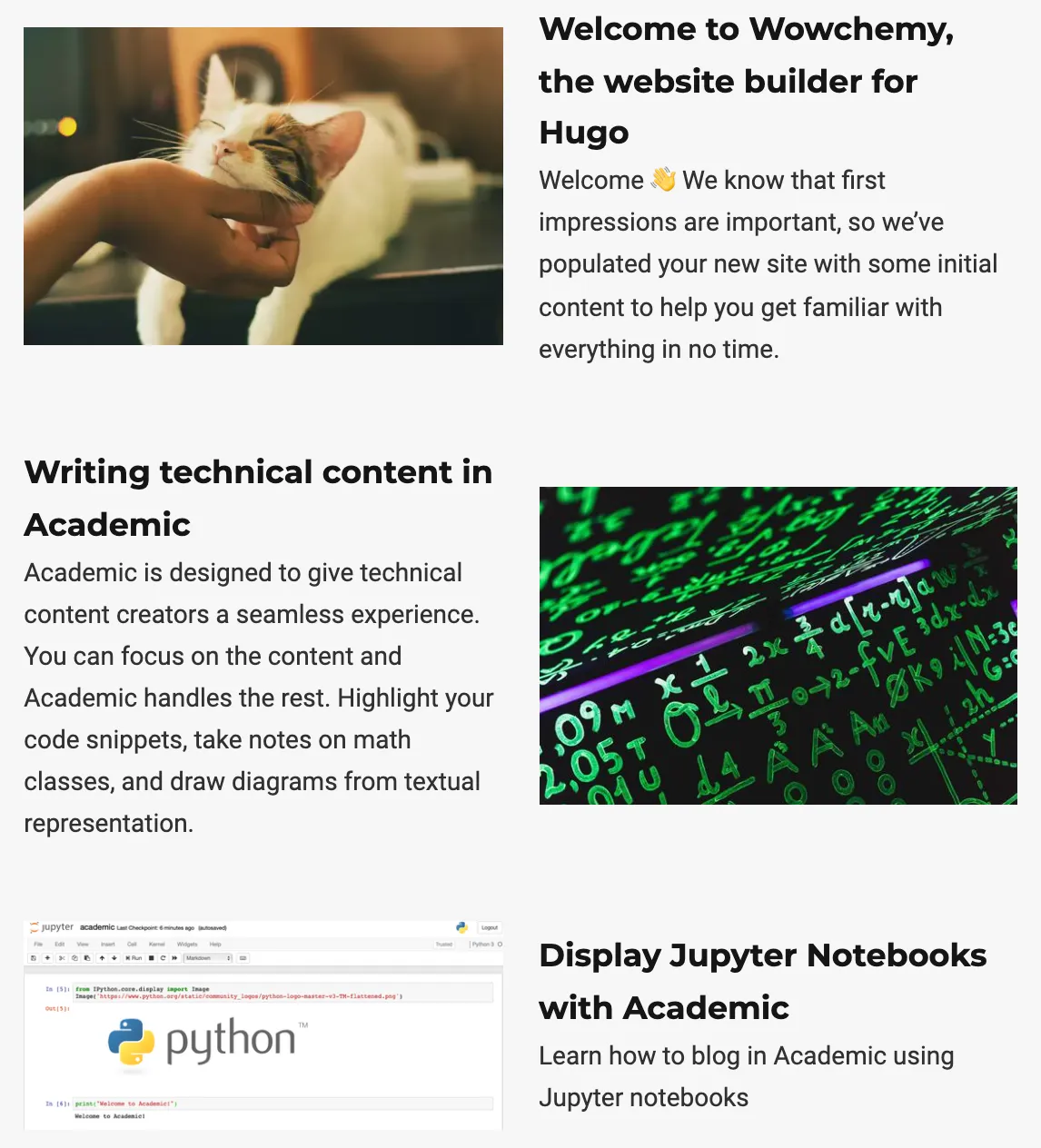
The compact view:
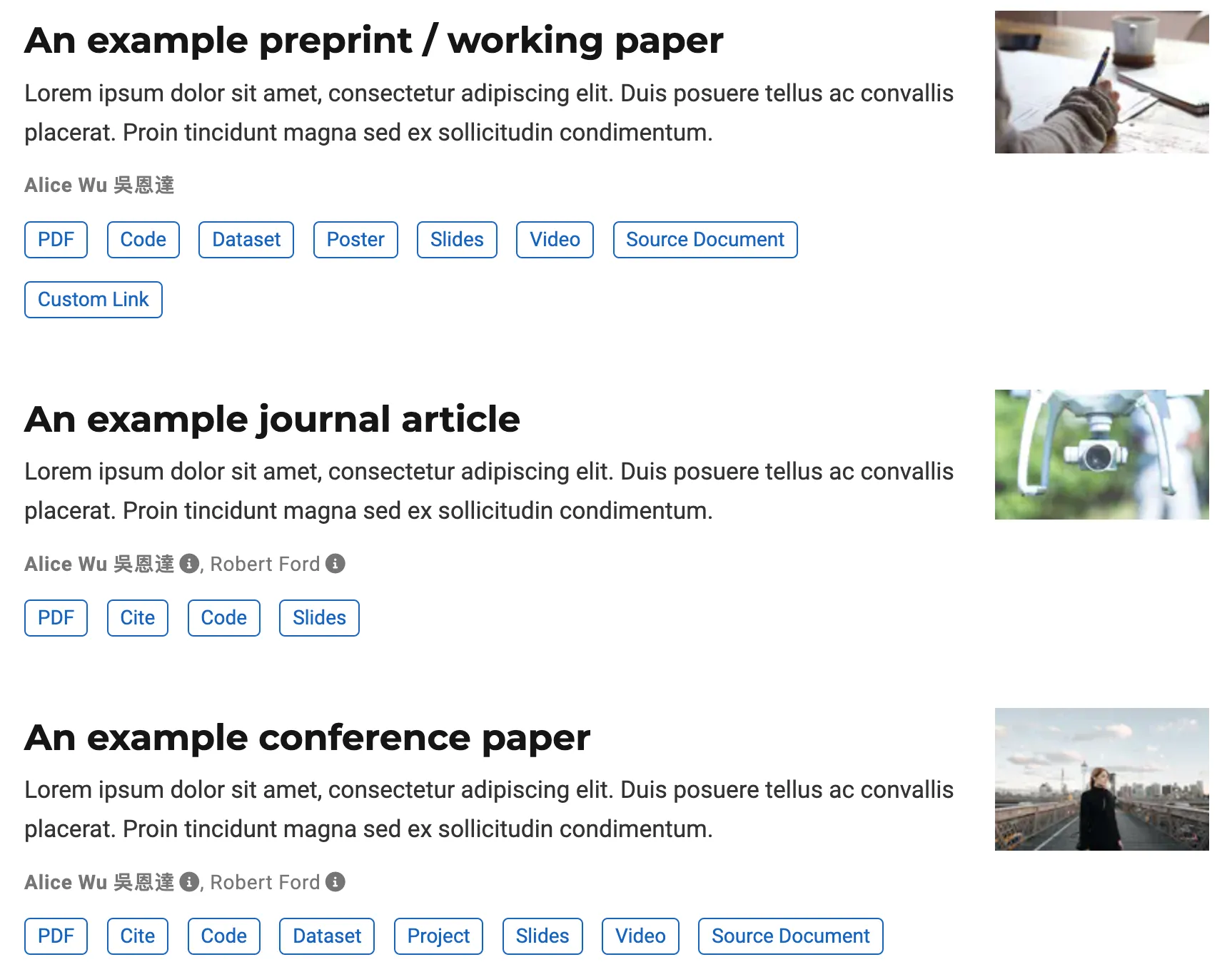
The card view:
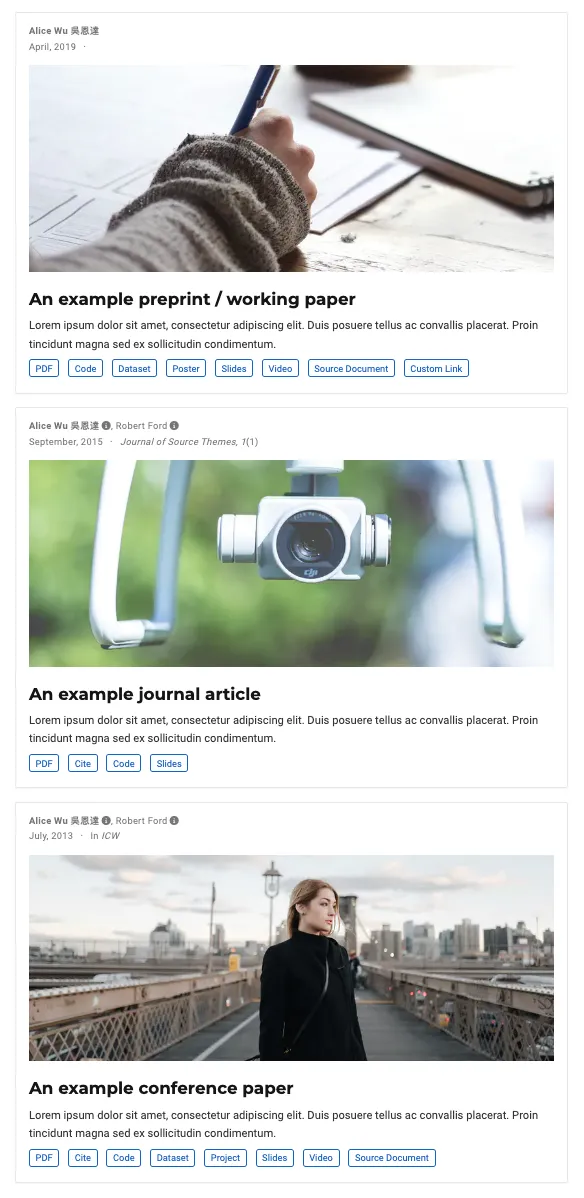
The citation view:
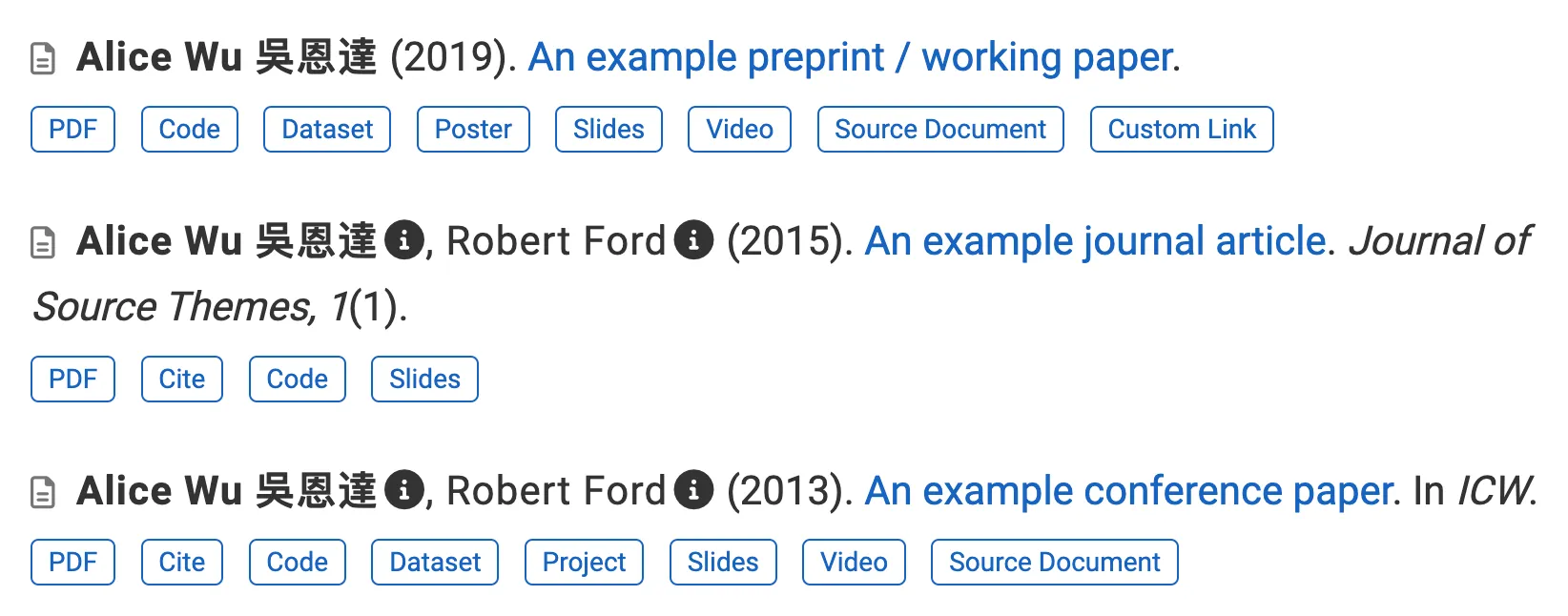
The list view:
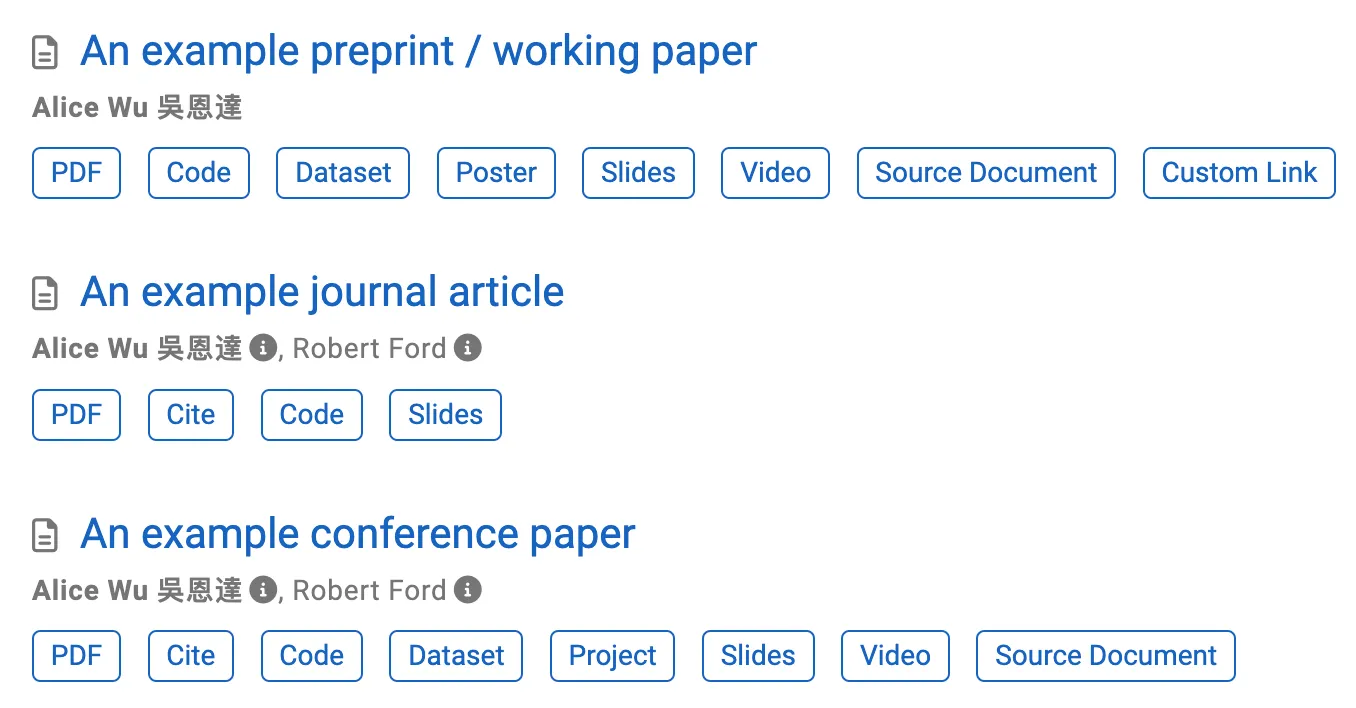
The following content previews are available:
- List (1)
- Compact (2)
- Card (3)
- Citation (4)
- For classic APA or MLA styled publication lists
- Optionally, edit the value of
citation_styleinparams.yamlto APA or MLA
- Showcase (5)
- Masonry
- Intended for use with the Portfolio widget to provide a Pinterest-style layout
- Or, create your own view in
layouts/partials/views/community/<name>.html(creating the folders) and reference it asview: community/<name>where<name>is a unique name for your view (with no spaces in the name)- take a look at the code for the built-in views for inspiration
- consider sharing your new view with the Community on Discord, or publishing it as a Hugo Module
For example, in your homepage at :
---# Page titletitle: My page# Page type - we want a landing page (such as a homepage)type: landing
# Your landing page sections - add as many different content blocks as you likesections: # A section to display blog posts - block: collection id: section-1 content: title: Section 1 subtitle: A subtitle text: Add any **markdown** formatted content here - text, images, videos, galleries - and even HTML code! # Display content from the `content/post/` folder filters: folders: - post design: # Choose how many columns the section has. Valid values: '1' or '2'. columns: '1' # Choose your content listing view - here we use the `showcase` view view: showcase # For the Showcase view, do you want to flip alternate rows? flip_alt_rows: true---What text is shown in the preview?
The built-in listings get the summary text for each listing from the page’s summary or abstract field. If you don’t provide that field, then Hugo will automatically generate a summary. You can also use Hugo’s <!—more—> summary divider in the body of your content, where you want to split the article.
Icons
The following icon packs are included:
hb- the Hugo Blox Icon Packbrands- the Brands Icon Packcustom- use your own SVG icons - see guide belowdevicon- the Developer Icon Pack which includes Python, RStudio, etc.hero- the Hero Icon Pack (outline variant)academicons- the Academicons Icon Pack
Specify icons in the form ICON_PACK/ICON_NAME.
For example, to use the sparkles icon from the hero icon pack, reference it as icon: hero/sparkles. Remember to type in lowercase.
The Brands Icon Pack, brands, includes the following brand icons:
- hugo
- github
- discord
x(Twitter)- telegram
- weixin
- mastodon
- youtube
- arxiv
- google-scholar
- orcid
Need to use a custom SVG icon?
Simply download the SVG icon to your assets/media/icons/custom/ folder. For example, if you download the Microsoft logo to assets/media/icons/custom/microsoft.svg, you can enter icon: "custom/microsoft" to show the icon.
Want inspiration? You can download SVG icons from sites like Font Awesome.
Note: SVG images may contain hardcoded sizes and colors. You may want to edit your SVG file in a text editor to remove any hard-coded sizes/colors/styles. Generally, the fill/stroke color within the SVG file should be set to currentColor if it isn’t already - then it will be dynamically colored depending on whether a light or dark theme is set.
Hugo Blox enables you to use a wide range of icons from Font Awesome and Academicons.
Icon pack “fab” includes the following brand icons:
- twitter, weixin, weibo, linkedin, github, facebook, pinterest, twitch, youtube, instagram, soundcloud
- See all icons
Icon packs “fas” and “far” include the following general icons:
- fax, envelope (for email), comments (for discussion forum)
- See all icons
The Academicons icon pack, icon_pack: ai, includes the following academic icons:
- cv, google-scholar, arxiv, orcid, researchgate, mendeley
- See all icons
You can enable the academic icon pack extension in params.yaml:
extensions: academicons: enable: trueIcon pack “emoji” gives you the ability to use emojis as icons
- See all icons
- Enter the emoji shortcode, such as
:heart:, in Hugo Blox’siconfield - or just use your emoji keyboard directly
Icon pack “custom” gives you the ability to use custom SVG icons
- Create an SVG icon in your favorite image editor or download one from a site such as Flat Icon
- Place the custom SVG icon in
assets/media/icons/, creating the folders if necessary - Reference the SVG icon name (without
.svgextension) in theiconfield - Custom icons are currently only supported in limited features such as the Features block - please help contribute to the issue to add custom icon support to all Hugo Blox features where an icon can be used
Background
A background can easily be applied to any homepage section. Choose from a range of background options including color, gradient, and image. Then choose either a dark or light text color by setting text_color_light, or remove text_color_light for dynamic text color associated with the current light/dark theme.
Once you have chosen the type of background, delete or comment out (by prefixing #) any unused options. For example, if you choose an image background, set the image and text_color_light options and delete the rest (delete color and gradient*). For colors, any HTML color name or Hex value is valid.
The following excerpts show the front matter structure for defining various backgrounds.
Color background:
design: background: # Choose a color such as from https://html-color-codes.info color: 'navy' # Text color (true=light, false=dark, or remove for the dynamic theme color). text_color_light: trueGradient background:
design: background: # Choose colors such as from https://html-color-codes.info gradient_start: '#4bb4e3' gradient_end: '#2b94c3' # The gradient angle from 0-360 degrees gradient_angle: 180 # Text color (true=light, false=dark, or remove for the dynamic theme color). text_color_light: trueImage background:
design: background: image: # Name of image in `assets/media/`. filename: background.jpg # Apply image filters? filters: # Darken the image? Range 0-1 where 1 is transparent and 0 is opaque. brightness: 0.6 # Image fit. Options are `cover` (default), `contain`, or `actual` size. size: cover # Image focal point. Options include `left`, `center` (default), or `right`. position: center # Use a fun parallax-like fixed background effect on desktop? true/false parallax: true # Text color (true=light, false=dark, or remove for the dynamic theme color). text_color_light: trueVideo background:
design: background: video: # Name of video in `assets/media/`. filename: background-video.mp4 # Post-processing: flip the video horizontally? flip: falseYou can also specify a background color (see Color Background) similar to the video for a better user experience whilst the video is loading.
Spacing
The spacing of sections can be controlled by specifying padding for the top, right, bottom, and left sides of sections.
For example, to make a section more compact, the following parameters can be added to the front matter of a section. This example will reduce the top and bottom spacing of the section to just 20 pixels (px).
design: spacing: # Customize the section spacing. Order is top, right, bottom, left. padding: ['20px', '0', '20px', '0']Style
It’s possible to customize the style of a specific instance of a widget with CSS. For example, the font size of a section can be changed.
First, define your custom style in CSS using the CSS Plugin feature.
To apply your new style to a widget, set css_class in a widget’s front matter. For example css_class: "MY_CSS_CLASS", where MY_CSS_CLASS is the name of the CSS class which you defined in the previous step. You can add multiple classes, separated by a space.
Custom CSS code can also be directly applied to a section using the css_style option.
design: css_style: '' css_class: ''